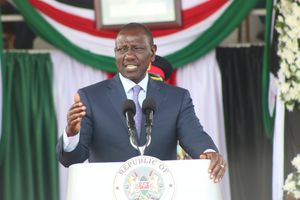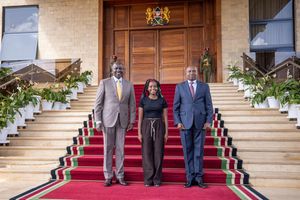
President William Ruto’s punitive taxes have created two sets of Kenyans.
For most Kenyans, 2024 was a year to forget. The year was characterised by economic hardships that were compounded by higher taxes and statutory deductions, which culminated in widespread protests that forced the government to withdraw the Finance Bill 2024.
The economy grew at its slowest pace in four years at 4.6 percent in the second quarter of the year — compared to 5.6 per cent in quarter two of 2023 — and is projected by the Central Bank of Kenya to record a full year growth of about 5.1 per cent, down from 5.6 per cent in 2023.
Sectors such as construction, mining and quarrying saw a contraction in the period, while agriculture, electricity and water supply, transport and storage, accommodation and food services, finance and insurance marked a slowdown in growth compared to the corresponding period in 2023.
Real wages also continued shrinking, with the private sector recording the first drop in average monthly pay for the first time in 30 years. Kenya Revenue Authority (KRA) data showed that in the quarter ending September, average private sector pay stood at Sh75,781, compared to Sh78,034 a year earlier.
In 2025, the CBK is projecting the economy will grow at 5.5 percent, while the International Monetary Fund (IMF) has a more conservative growth target of 5.0 percent.
It was not all doom and gloom however, as the country’s inflation rate fell significantly to a 17-year low of 2.7 per cent by October on falling food and energy prices, offering relief to cash strained households.
The shilling appreciated against the dollar by 20.9 percent in the year, offering relief to consumers through lower costs of imported goods and fuel. In February, the shilling had depreciated to an all-time low of Sh161 to the dollar, before gaining to end the year at Sh129.29.
Investors in the financial markets also had a good year, with the Nairobi Securities Exchange (NSE) recording its best performance in years and bonds continuing to pay double digit gains.
In the New Year, Kenyans will be hopeful of a continuation of the revival of the economy, but some pain points remain on the horizon.
Some of the key economic events and trends to look out for in the new year include:
New taxes coming in the Finance Bill 2025
The 2024 Budget Review and Outlook Paper (BROP) outlined government plans to raise an additional Sh343 billion in tax revenue in the 2025/2026 fiscal year, signalling additional taxes that risk a fresh round of social unrest.
The 2024 Finance Bill was withdrawn by the government after widespread protests led by the youth, but the government brought back a large number of the rejected clauses through the Tax Laws Amendment Act 2024, which was signed into law on December 11.
These revived measures included higher excise duty on alcohol products, internet data, imported ceramic tiles, glass products and washbasins and betting.
Additional tax measures loom in the new Finance Bill which is set to be tabled before the end of April. This bill will underpin the KRA’s mammoth task of raising Sh2.732 trillion in tax revenue, an increase of 14.4 percent from the Sh2.389 trillion that is projected for the current fiscal year that ends in June 2025.
This could well see the government revive yet more clauses that were in the rejected 2024 Bill, as well as ramping up efforts to bring more Kenyans into the tax net.
According to the projections, the Treasury is eyeing an increase in income taxes by 11.9 percent to Sh1.32 trillion, Value Added tax (VAT) by 13.3 percent to Sh820.3 billion, excise duty by 20 percent to Sh389.6 billion and import duty by 25.8 percent to Sh201.3 billion.
Enhanced NSSF contributions from February
Employees are set for an increase in their monthly contributions to the National Social Security Fund (NSSF) from February, as the third year of the graduated increases in the deductions kicks in.
The fund is adjusting both the lower income limit for pensionable pay from Sh7,000 to Sh8,000, and for the upper income limit from Sh36,000 to Sh72,000. Employees and their employers both contribute to the fund at a rate of six per cent each.
This means that the minimum NSSF contribution per employee rises to Sh480 from Sh420 per month, while the top contribution per employee (for those earning Sh72,000 and above per month) rises to Sh4,320 from the present Sh2,160.
The higher deductions, which kick in on the February 2025 payslips.
The contributions are made in two tiers. Tier one contributions, which relate to pensionable earnings up to the lower earnings limit (six percent of Sh8,000) are mandatory contributions to NSSF.
Tier two contributions (those above the minimum earnings limit) can be placed within an existing pension scheme with the approval of the Retirement Benefits Authority (RBA).
African Growth and Opportunity Act (Agoa) expires in September
The Agoa pact, which provides eligible sub-Saharan African countries with duty-free access to the US market for more than 1,800 products, expires in September 2025.
Under the pact, Kenya has been exporting billions of shillings’ worth of apparel to the US every year, supporting thousands of jobs in the country’s special economic zones and contributing significantly to Kenya’s total exports of Sh64.3 billion to the US in 2023.
In the two decades of Agoa, Kenya has exported more than $6.5 billion (Sh840 billion) worth of garments to the US duty free.
There is optimism of an extension to the deal, with the Office of US Trade Representative (USTR) signalling that it strongly supports the renewal of the programme that has been in place since the year 2000.
A key stumbling block could however come in the form of newly elected US president Donald Trump, who has previously stated that Agoa should not be renewed on account of foreign policy disagreements between the US and some of the Agoa partners.
Mr Trump’s America First trade stance is more likely to see the US pursue standalone trade deals, which allow the world’s largest economy greater access to the partner markets than is currently the case with deals like Agoa.
Investment income: What to expect from bonds, listed shares and bank deposits
2024 was a good year for financial investors in government securities and shares listed on the Nairobi Securities exchange (NSE).
Bond investors enjoyed up to 18.5 percent in interest from a tax free infrastructure bond, which represented the high water mark for the elevated interest rate environment that characterised the market for most of the year.
Those keeping their cash in fixed deposits in banks also saw higher returns on the year, averaging 10.86 percent on the 11 months to November 2024, compared to 8.13 percent in the corresponding period in 2023.
The highest returns were however available on equities, where investor wealth at the NSE grew by 34.8 percent or Sh500.7 billion to Sh1.939 trillion in 2024, as multiple stocks including all listed banks, Safaricom and EABL recorded double digit price gains.
Analysts expect that equities will continue to record positive performance in the coming year, with returns from fixed income assets such as bonds expected to decline in line with the ongoing fall in interest rates.
The declining interest rates are likely to see capital flow into equities, raising demand for shares and therefore prices, while foreign capital is also likely to come into frontier and emerging markets like Kenya as the US continues to cut its lending rates.
IMF funding programme for Kenya expires in April
The four-year IMF funding programme for Kenya will expire in April 2025, bringing to an end a funding line that has been Kenya’s primary external borrowing source since 2020.
The programme, which is under the extended credit facility and extended fund facility (ECF/EFF) cannot be extended since Kenya will be exhausting it’s allowed access limit to IMF cash.
Kenya’s access limit is set at six times its quota, equivalent to $4.33 billion (Sh560 billion), with the ninth and last drawdown under the current programme expected to push the country to this limit.
There have been some positive noises from the IMF and the government about the possibility of a new programme or standby facility being agreed upon, although this will likely take months of negotiations.
Kenya will also need to address its perennial balance of payment problems before it engages the IMF.
Banks minimum capital to increase to Sh3 billion
Commercial banks will see their minimum statutory capital requirement rise to Sh3 billion from the current Sh1 billion, following the signing of the Business laws (Amendment) Act, 2024.
The updated regulations require that lenders raise their minimum core capital progressively to Sh10 billion over the next five years, starting with the increase to Sh3 billion by December 2025.
The minimum capital will go up to Sh5 billion by the end of 2026, and Sh7 billion by the end of 2027. The floor will rise further to Sh8 billion by December 2028, and finally to Sh10 billion in 2029.
By the end of September 2024, 12 banks did not meet the Sh3 billion core capital threshold, meaning that they will have to raise new funds over the next 12 months. Banking sector experts expect that the higher capital requirements will accelerate consolidation of the sector through mergers and acquisitions, resulting in larger, better capitalised banks.
Government to Government fuel import deal extended into 2025
The government to government (G to G) fuel import deal that the State struck with three Gulf oil majors has been extended into 2025, having been set to lapse at the end of December 2024.
Kenya signed the deal with Saudi Aramco, Abu Dhabi National Oil Corporation (Adnoc) and Emirates National Oil Company (Enoc) in April 2023 for the importation of fuel on a 180-day credit period, reducing the need for monthly raids on the forex market by fuel importers.
The deal was meant to reduce pressure on the shilling by ending monthly demand of over $500 million that oil dealers needed to pay for fuel on spot markets under the Open Tender System that was in use before the entry of the three Gulf firms.









